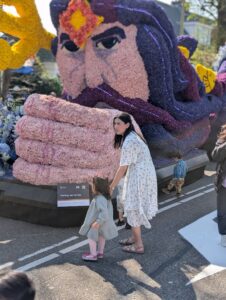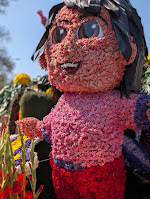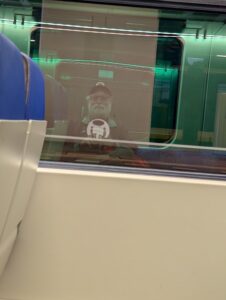 The Dutch Flower Parade is one of the great annual events I had never heard of before.
The Dutch Flower Parade is one of the great annual events I had never heard of before.
I had to go.
It consists of a kilometer-long series of petal-covered floats, each with a theme, a sponsor, and its own pre-recorded music. It celebrates the tulips, which fill huge fields and are grown for their bulbs.
The parade starts on the seacoast, comes inland to the town of Sassenheim, then heads north to Haarlem. It takes all day. They set out at 10:30 and don’t get to Haarlem until well past dark.
 I had to go there. I targeted Sassenheim, where the parade was due to arrive about lunchtime. Then I headed to the nearest train station with my bike and its “fietspass,” a $10 ticket that lets you take it on the trains in off-peak hours and on weekends.
I had to go there. I targeted Sassenheim, where the parade was due to arrive about lunchtime. Then I headed to the nearest train station with my bike and its “fietspass,” a $10 ticket that lets you take it on the trains in off-peak hours and on weekends.
My train line to Utrecht was closed, so I rode in, 7 miles or 11 km. The Netherlands train system has two kinds of trains, a “sprinter” that stops at every station and an “Intercity” that skips the small stops. I planned to take sprinters. They handle bikes better.
The sprinter was full of bikes when we hit Leiden, the last stop before Sasssenheim. But now hundreds of people wanted to get on, and the conductor wanted the bikes off. I snuck into the passenger area, creating a path for people to enter, and prayed I wouldn’t see my bike tossed on the platform.
The Long Way Home

It looked like I could easily make Leiden. This was just 8 km, or five miles away. Easy. Nice paths, friendly people. Got lost a few times but that’s tourism.
On arrival at Leiden’s train station, I looked at its list of departures. There was nothing to Utrecht. Zero. Nada. The only solution I could imagine was biking to The Hague. This was another 18 kilometers, about 12 miles. On a rented e-bike that was already hurting my butt.
But that’s what Opa Fiets faced, and that’s what Opa Fiets did. In Atlanta this is the equivalent of rolling into town from Stone Mountain. In the Netherlands the suburbs barely exist. You’re either in town or you’re in the country. I found some beautiful paths, and wound up rolling alongside students, long-distance cyclists in Spandex, and dozens of folks my own age, all of whom were wearing helmets.
I thought fietsers didn’t wear helmets, but here’s a news flash. Old fietsers do. Accident rates on Dutch cycles increase dramatically once we hit 70, so most old fietsers wear helmets. So do all the road bikers. I wish I had taken pictures.
Exhaustion

When I reached Utrecht Centraal, of course, I was exhausted, and faced another 7 miles back to Maarssen, where I’m staying. I gave the map program the address of a restaurant I’d enjoyed in the village and set out.
I learned something on that ride. If you ride to Maarssen Village, you ride by a glorious canal all the way into town, a beautiful and even hypnotic ride in the early evening.
The Last Crisis

A block from the restaurant, with victory in sight, my cellphone fell out of my jacket pocket. It clattered onto the street. I stopped in an absolute panic, waiting to hear the sickening crunch of my road home being destroyed.
But by some miracle the car that was following me was a driver’s ed car, and the instructor told his student to hit the brakes. Which she did. They both smiled at me as I picked up the phone, which was undamaged.
Dinner was sublime. The place wasn’t crowded. The restaurant owner knew me by now and quickly set out a big beer for me. I had fresh salmon covering creamy potatoes, baby shrimp and mayo, with brownies for dessert. I stayed there for two hours, soaking in the quiet like a bath, before I took the last of that sunshine back to my bed, the motor on high, the wheels having memorized the road home.
This is the difference between tourism and slow tourism. You learn the place and meet some people. You find the good stuff, and for a moment are at home in a town you’ve never been to before.









